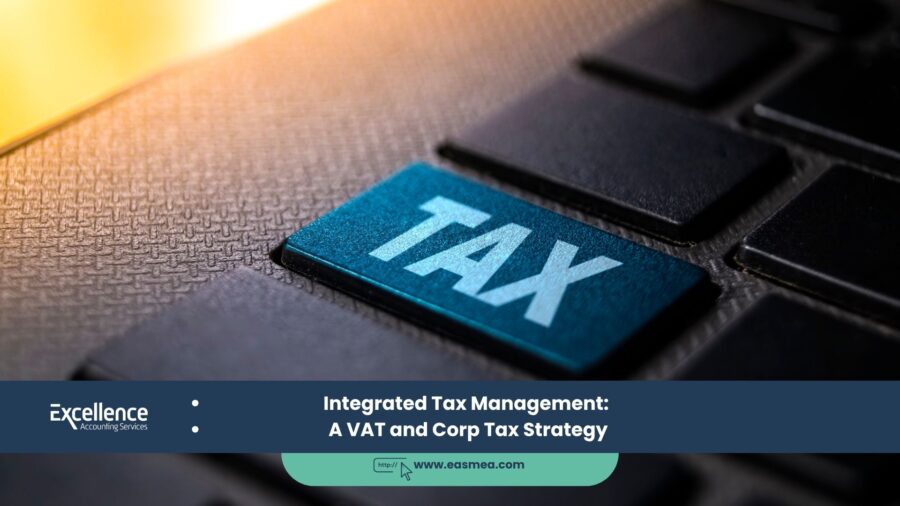Integrated Tax Management: A VAT and Corp Tax Strategy
The UAE’s economic identity has evolved. The era of a largely tax-free environment has been replaced by a mature, structured economy featuring two distinct but interconnected tax regimes: Value Added Tax (VAT) and Corporate Tax (CT). For businesses, this new reality demands a significant evolution in thinking. Managing VAT and CT in separate, isolated silos is not just inefficient; it’s a direct route to compliance risks, missed financial optimizations, and significant administrative burdens. The future of effective financial management in the UAE lies in an integrated tax strategy.
- Integrated Tax Management: A VAT and Corp Tax Strategy
- Part 1: The New Reality - Why an Integrated Strategy is Non-Negotiable
- Part 2: The Core Pillars of an Integrated Tax Strategy
- Part 3: The Power of Unified Technology
- What Excellence Accounting Services (EAS) Can Offer
- Frequently Asked Questions (FAQs)
- Build Your Unified Tax Strategy Today.
An integrated approach treats tax not as two separate compliance tasks, but as a single, unified financial function. It recognizes that the data, transactions, and strategic decisions that drive one tax directly impact the other. A disjointed approach, where the VAT team and the CT team operate independently, can lead to conflicting tax positions, data discrepancies that trigger FTA audits, and a failure to see the complete financial picture. This guide provides a strategic framework for breaking down these silos, outlining the core pillars of an integrated VAT and Corporate Tax strategy that enhances compliance, optimizes cash flow, and supports sustainable business growth.
Key Takeaways for Integrated Tax Management
- Single Source of Truth: Both VAT and Corporate Tax rely on the same set of financial data. Data consistency is paramount to avoid audit triggers.
- Interconnected Compliance: The figures in your VAT returns must reconcile with the annual revenue and expenses reported in your Corporate Tax return.
- Holistic Transaction Planning: Major business decisions, from asset purchases to restructuring, must be analyzed through both a VAT and CT lens simultaneously.
- Technology is the Enabler: A unified accounting system is essential for managing the complexities of both tax regimes from a single platform.
- Beyond Compliance to Optimization: An integrated strategy uncovers opportunities for tax efficiency and improved cash flow management that are invisible when taxes are managed in isolation.
Part 1: The New Reality – Why an Integrated Strategy is Non-Negotiable
The relationship between VAT and Corporate Tax is symbiotic. They are two different outputs derived from the same core set of economic activities and financial data. Ignoring this connection is a significant strategic error.
The Data Consistency Imperative
The Federal Tax Authority (FTA) has a comprehensive view of your business’s financial data. They can, and will, compare the total revenue declared across your periodic VAT returns with the annual revenue reported in your financial statements for Corporate Tax.
Any significant, unexplained discrepancies between these two figures are one of the biggest red flags for a tax audit. An integrated strategy ensures that a single, accurate, and reconciled set of financial data serves as the foundation for all tax filings.
This demands meticulous accounting and bookkeeping from day one.
The Ripple Effect of a Single Transaction
Consider the purchase of a new delivery vehicle. This single transaction has immediate and long-term implications for both taxes:
- VAT Impact: You must ensure the tax invoice is correct to recover the input VAT in your next return, impacting your immediate cash flow.
- CT Impact: The cost of the vehicle (net of recoverable VAT) is capitalized and then depreciated over several years, affecting your taxable profit annually.
A siloed approach might handle the VAT claim efficiently but record the asset’s cost for CT incorrectly (e.g., including the recoverable VAT). An integrated strategy ensures both implications are managed correctly and consistently from the moment the transaction occurs.
Part 2: The Core Pillars of an Integrated Tax Strategy
Building a robust, integrated framework requires focusing on four key strategic pillars.
Pillar 1: Unified Data and Technology
The bedrock of an integrated strategy is a single, centralized accounting system. Relying on disparate spreadsheets or separate software for VAT and corporate accounting is a recipe for disaster. A modern ERP or a cloud accounting solution like Zoho Books is essential. The system must be configured with a tax-sensitive chart of accounts that can tag transactions relevant to both VAT (e.g., zero-rated, exempt) and CT (e.g., non-deductible entertainment). A professional accounting system implementation is critical to setting up this foundation correctly.
Pillar 2: Consistent Tax Positions and Policies
Your business must adopt consistent policies for how it treats various financial elements across both tax regimes.
- Revenue Recognition: The timing of when you recognize revenue for Corporate Tax should align with the ‘time of supply’ rules for VAT. Having different policies can create reconciliation nightmares.
- Expense Treatment: The categorization of expenses must be consistent. An expense flagged as partially deductible for CT (like entertainment) needs to be managed in a way that doesn’t compromise a valid input VAT claim.
This consistency requires clear internal policies and often the guidance of expert VAT consultants and Corporate Tax advisors.
Pillar 3: Strategic Transaction Planning
Major business decisions must be viewed through a dual tax lens. Before entering into any significant transaction—be it a merger, acquisition, major asset purchase, or corporate restructuring—a holistic tax impact analysis is crucial.
- Business Sale: Selling a business as a “transfer of a going concern” (TOGC) may be outside the scope of VAT, but the structure of the sale (asset vs. share sale) has vastly different implications for the seller’s Corporate Tax liability.
This level of foresight requires integrated business consultancy and thorough due diligence.
Pillar 4: Integrated Compliance and Reporting
Your compliance processes should be merged into a single, cohesive workflow. This means creating a unified tax calendar and, most importantly, establishing a process for regular reconciliation. The data from your monthly or quarterly VAT return filing should be reconciled against your management accounts. At year-end, these reconciliations become the backbone of preparing your annual financial statements and, subsequently, your Corporate Tax return. Accurate financial reporting is the bridge that connects your VAT and CT compliance.
Part 3: The Power of Unified Technology
The complexity of managing two tax regimes makes technology an indispensable ally. A unified accounting platform is the practical tool that brings an integrated strategy to life.
Why Zoho Books is a Strategic Choice
A solution like Zoho Books is built for the modern UAE tax environment. It’s not just a bookkeeping tool; it’s a central hub for tax management.
- FTA-Approved VAT Management: It automates VAT calculations and generates compliant tax returns.
- Expense Tracking for CT: It allows you to categorize expenses in line with CT deductibility rules, ensuring your financial data is ready for year-end tax calculations.
- Single Data Repository: It eliminates the risk of data discrepancies by ensuring that the information used for VAT returns and annual accounts comes from the exact same source.
What Excellence Accounting Services (EAS) Can Offer
At EAS, we specialize in breaking down tax silos. Our services are designed to provide a holistic, integrated approach to tax management, ensuring your business is not just compliant, but strategically positioned for financial efficiency.
- Holistic Tax Advisory: We don’t just advise on VAT or Corporate Tax; we advise on your total tax position, ensuring all strategies are aligned.
- Integrated Accounting and Bookkeeping: Our accounting services create the unified data foundation essential for integrated tax compliance.
- Comprehensive Tax Health Checks: We conduct detailed reviews, similar to an internal audit for tax, to identify inconsistencies between your VAT and CT positions before they become a problem.
- Strategic Financial Leadership: Our virtual CFO services embed a tax-aware mindset into your high-level financial planning and strategic decision-making.
- Account Reconciliation Services: We provide specialized account reconciliation services to ensure your VAT filings and financial statements are in perfect harmony.
Frequently Asked Questions (FAQs)
Your VAT returns provide the FTA with a periodic declaration of your revenue. The total revenue declared across these returns will be reconciled against the annual revenue in your audited financial statements, which is the starting point for your CT calculation. Major discrepancies can trigger an audit where you’ll have to justify the difference.
While the VAT law allows some small businesses to use the cash accounting scheme, UAE Corporate Tax must be calculated based on financial statements prepared under the accrual basis of accounting. This difference in basis is a major complexity and a key reason why an integrated approach with careful reconciliations is essential.
Generally, yes. The ability to recover input VAT is based on whether the expense was for making taxable supplies. The deductibility of that same expense for CT is based on the “wholly and exclusively” business purpose rule. For example, you can recover input VAT on a client entertainment expense, but you can only deduct 50% of the net cost for CT purposes.
They are legally separate concepts with different qualifying conditions. You can have a VAT Group without being eligible for a CT Group, and vice versa. An integrated strategy means evaluating the pros and cons of forming each type of group and understanding how transactions between group members are treated under both laws.
The best practice is to perform a reconciliation on a periodic basis (monthly or quarterly). This involves starting with the total revenue from your accounting system and adjusting for differences in timing, non-taxable revenue, and other factors to arrive at the figure declared on the VAT return. This creates a clear audit trail for the year-end reconciliation.
Yes, indirectly. While VAT is concerned with the value of the supply, transfer pricing rules for CT require transactions between related parties to be at “arm’s length.” If a tax audit adjusts your transfer prices for CT, it could lead the FTA to question the valuation used for VAT purposes on those same transactions, potentially leading to VAT adjustments as well.
The recoverable input VAT should be excluded from the capital cost of the asset. Depreciation for Corporate Tax should only be calculated on the net cost of the asset (Purchase Price – Recoverable VAT). Including VAT in the asset’s cost base would lead to overstating your depreciation expense.
The risks are immense: data entry errors, lack of version control, formula mistakes, inconsistencies in data, no clear audit trail, and an inability to get a real-time, holistic view of your tax position. It is an outdated and highly risky approach in the current regulatory environment.
It’s even more critical. A Qualifying Free Zone Person must meet strict conditions to benefit from the 0% CT rate on qualifying income. This involves meticulously tracking qualifying vs. non-qualifying revenue and expenses. This data must also align perfectly with your VAT obligations, which may differ depending on whether you are in a Designated Zone and the nature of your transactions.
A unified Chart of Accounts is the blueprint for your financial data. By designing it with specific accounts for different types of income and expenses relevant to both taxes (e.g., separate accounts for local vs. exported services, or for fully deductible vs. partially deductible expenses), you automate the process of data segregation. This makes reporting for both VAT and CT faster, more accurate, and far more efficient.
Conclusion: From Dual Compliance to a Singular Strategy
In the new UAE tax landscape, managing VAT and Corporate Tax are not two separate races; they are two legs of the same relay. Success depends on a smooth, coordinated handover between them. By adopting an integrated tax strategy built on unified technology, consistent policies, and holistic planning, businesses can move beyond the stress of dual compliance. They can achieve a state of strategic control, unlocking efficiencies, minimizing risks, and turning their tax function into a source of value and a competitive advantage.




